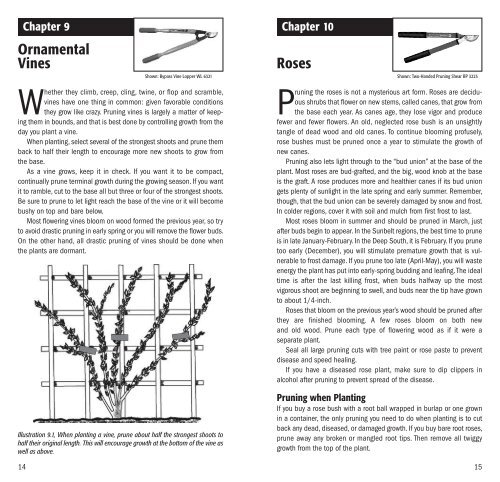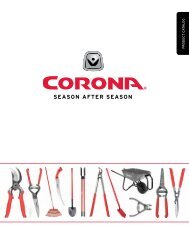Pruning Principles 2009 - Corona Tools
Pruning Principles 2009 - Corona Tools
Pruning Principles 2009 - Corona Tools
You also want an ePaper? Increase the reach of your titles
YUMPU automatically turns print PDFs into web optimized ePapers that Google loves.
Chapter 9<br />
Chapter 10<br />
Ornamental<br />
Vines<br />
Shown: Bypass Vine Lopper WL 6321<br />
Roses<br />
Shown: Two-Handed <strong>Pruning</strong> Shear BP 3225<br />
Whether they climb, creep, cling, twine, or flop and scramble,<br />
vines have one thing in common: given favorable conditions<br />
they grow like crazy. <strong>Pruning</strong> vines is largely a matter of keeping<br />
them in bounds, and that is best done by controlling growth from the<br />
day you plant a vine.<br />
When planting, select several of the strongest shoots and prune them<br />
back to half their length to encourage more new shoots to grow from<br />
the base.<br />
As a vine grows, keep it in check. If you want it to be compact,<br />
continually prune terminal growth during the growing season. If you want<br />
it to ramble, cut to the base all but three or four of the strongest shoots.<br />
Be sure to prune to let light reach the base of the vine or it will become<br />
bushy on top and bare below.<br />
Most flowering vines bloom on wood formed the previous year, so try<br />
to avoid drastic pruning in early spring or you will remove the flower buds.<br />
On the other hand, all drastic pruning of vines should be done when<br />
the plants are dormant.<br />
Illustration 9.1, When planting a vine, prune about half the strongest shoots to<br />
half their original length. This will encourage growth at the bottom of the vine as<br />
well as above.<br />
14<br />
<strong>Pruning</strong> the roses is not a mysterious art form. Roses are deciduous<br />
shrubs that flower on new stems, called canes, that grow from<br />
the base each year. As canes age, they lose vigor and produce<br />
fewer and fewer flowers. An old, neglected rose bush is an unsightly<br />
tangle of dead wood and old canes. To continue blooming profusely,<br />
rose bushes must be pruned once a year to stimulate the growth of<br />
new canes.<br />
<strong>Pruning</strong> also lets light through to the “bud union” at the base of the<br />
plant. Most roses are bud-grafted, and the big, wood knob at the base<br />
is the graft. A rose produces more and healthier canes if its bud union<br />
gets plenty of sunlight in the late spring and early summer. Remember,<br />
though, that the bud union can be severely damaged by snow and frost.<br />
In colder regions, cover it with soil and mulch from first frost to last.<br />
Most roses bloom in summer and should be pruned in March, just<br />
after buds begin to appear. In the Sunbelt regions, the best time to prune<br />
is in late January-February. In the Deep South, it is February. If you prune<br />
too early (December), you will stimulate premature growth that is vulnerable<br />
to frost damage. If you prune too late (April-May), you will waste<br />
energy the plant has put into early-spring budding and leafing.The ideal<br />
time is after the last killing frost, when buds halfway up the most<br />
vigorous shoot are beginning to swell, and buds near the tip have grown<br />
to about 1/4-inch.<br />
Roses that bloom on the previous year’s wood should be pruned after<br />
they are finished blooming. A few roses bloom on both new<br />
and old wood. Prune each type of flowering wood as if it were a<br />
separate plant.<br />
Seal all large pruning cuts with tree paint or rose paste to prevent<br />
disease and speed healing.<br />
If you have a diseased rose plant, make sure to dip clippers in<br />
alcohol after pruning to prevent spread of the disease.<br />
<strong>Pruning</strong> when Planting<br />
If you buy a rose bush with a root ball wrapped in burlap or one grown<br />
in a container, the only pruning you need to do when planting is to cut<br />
back any dead, diseased, or damaged growth. If you buy bare root roses,<br />
prune away any broken or mangled root tips. Then remove all twiggy<br />
growth from the top of the plant.<br />
15



